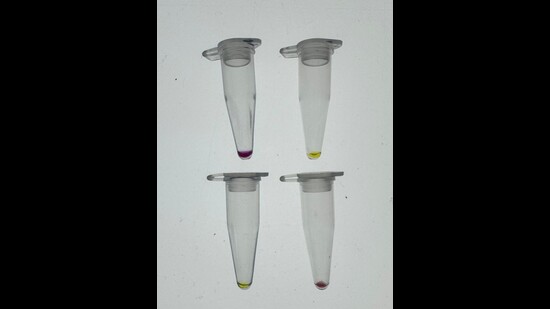Our Terms & Conditions | Our Privacy Policy
IISER scientists pioneer affordable RNA sensors for fast detection of Covid-19, Zika
Researchers from the Indian Institute of Science Education and Research (IISER) Pune have developed an improved, low-cost diagnostic method to detect viral infections such as Covid-19 and Zika. The research, published in a scientific journal titled ACS Synthetic Biology on May 29, 2025, demonstrates a novel approach to enhancing the sensitivity and speed of RNA-based diagnostics using synthetic biology tools known as toehold switches.
The police have recovered the body of a 67-year-old man from river water near Chhatrapati Shivaji Maharaj Bridge at around 12.30pm on Saturday, said officials. (HT)
The core team behind the study includes Tanvi Kale, Rudvi Pednekar, and Professor Chaitanya Athale from IISER Pune’s Department of Biology. The project was carried out in close collaboration with international partners—Dr Keith Pardee from the University of Toronto, Canada, and Dr Fernán Federici from Pontificia Universidad Católica de Chile.
The initiative was funded by the Shastri Indo-Canadian Institute and the International Development Research Centre (IDRC), Canada, supporting its development as part of a global effort to make diagnostics more accessible.
Toehold switches, which are synthetic RNA devices designed to detect specific sequences of viral RNA, function like molecular switches. When these biosensors come into contact with target RNA from viruses like SARS-CoV-2 or Zika, they activate a visible output—often a colour change—enabling straightforward detection. Thus, serving as a “genetic device”, said Chaitanya Athale, faculty member, IISER, Pune, who led the study.
The IISER team enhanced this mechanism by engineering the RNA sensors with ‘translational enhancers,’ small genetic sequences that increase the output signal by boosting protein production. This not only shortens the detection time but also makes the signal more easily visible to the naked eye, improving the overall effectiveness of the test.
What sets this diagnostic innovation apart is its simplicity and adaptability. The test can be formatted onto paper strips, making it a portable tool that can be used even outside laboratory settings. This is particularly critical in remote or underserved areas where access to conventional testing infrastructure is limited. Since the system relies on programmable RNA technology, the same platform can be quickly adapted to detect other viruses by simply reprogramming the toehold sequences, giving it a broad range of applications beyond Covid-19 and Zika.
The improved RNA biosensors have been validated in laboratory conditions and are expected to move toward field trials shortly. If implemented widely, they could significantly aid public health efforts by providing a rapid, affordable, and scalable solution for viral detection. This innovation comes at a time when global health systems are actively seeking resilient tools to prepare for and manage future pandemics. By making diagnostics more accessible and faster, the IISER Pune team’s research could serve as a cornerstone in strengthening health security, especially in resource-limited regions across the globe.
Images are for reference only.Images and contents gathered automatic from google or 3rd party sources.All rights on the images and contents are with their legal original owners.



Comments are closed.